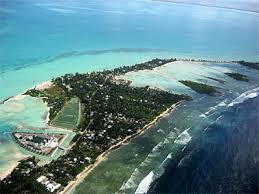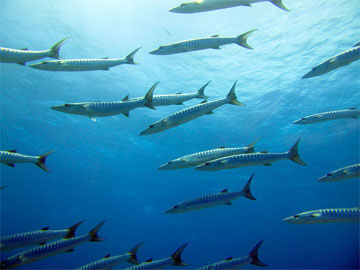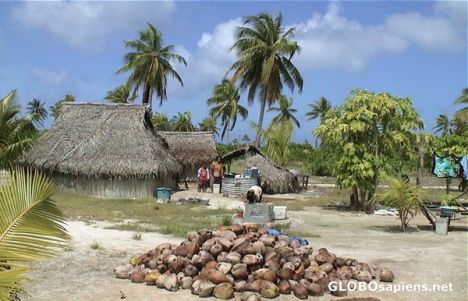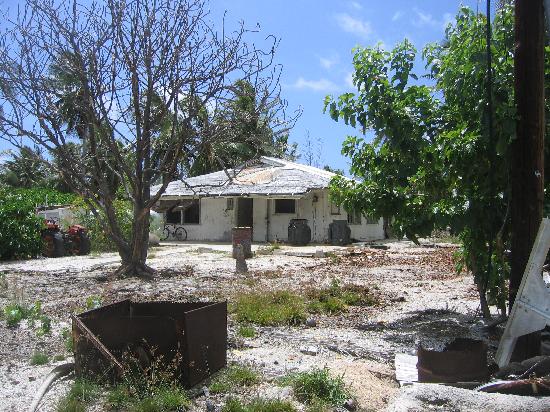
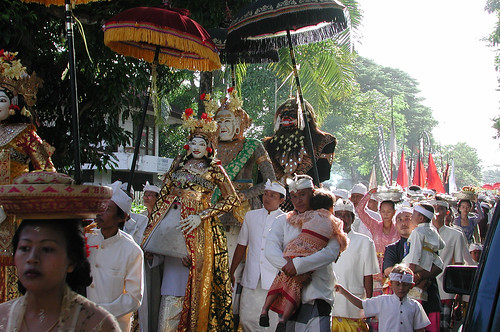






Every religion or culture all over the world has their own way to define and celebrate their new year. For example, the Chinese have the Imlek year and to celebrate it, have, as they called it in their own language, "Gong Xi Fat Choy". The Moslem societies have their Muharam year, and any of the people over the world using the Gregorian calendar, celebrate the New Year on January 1st.
The same thing also occurs in Bali, however the Balinese use many different calendar systems. They have adopted the Gregorian calendar for business and government purposes. But for the endless procession of holy days, temple anniversaries, celebrations, sacred dances, building houses, wedding ceremonies, death and cremation processes and other activities that define Balinese life, they have two calendar systems. The first is the Pawukon (from the word Wuku which means week) and Sasih (which is means month). Wuku consists of 30 items starting from Sinta, the first Wuku and end up with the Watugunung the last one. The Pawukon, a 210-day ritual calendar brought over from Java in the 14th century, is a complex cycle of numerological conjunctions that provides the basic schedule for ritual activities on Bali. Sasih, a parallel system of Indian origin, is a twelve month lunar calendar that starts with the vernal equinox and is equally important in determining when to pay respect to the Gods.
Westerners open the New Year in revelry, however, in contrast, the Balinese open their New Year in silence. This is called Nyepi Day, the Balinese day of Silence, which falls on the day following the dark moon of the spring equinox, and opens a new year of the Saka Hindu era which began in 78 A.D.
Nyepi is a day to make and keep the balance of nature. It is based on the story of when King Kaniska I of India was chosen in 78 A.D. The King was famous for his wisdom and tolerance for the Hinduism and Buddhism societies. In that age, Aji Saka did Dharma Yatra (the missionary tour to promote and spread Hinduism) to Indonesia and introduce the Saka year.
The lead upto Nyepi day is as follows:
- Melasti or Mekiyis or Melis (three days before Nyepi)
Melasti is meant to clean the pratima or arca or pralingga (statue), with symbols that help to concentrate the mind in order to become closer to God. The ceremony is aimed to clean all nature and its content, and also to take the Amerta (the source for eternal life) from the ocean or other water resources (ie lake, river, etc). Three days before Nyepi, all the effigies of the Gods from all the village temples are taken to the river in long and colourful ceremonies. There, they have are bathed by the Neptune of the Balinese Lord, the God Baruna, before being taken back home to their shrines. - Tawur Kesanga (the day before Nyepi)
Exactly one day before Nyepi, all villages in Bali hold a large exorcism ceremony at the main village cross road, the meeting place of demons. They usually make Ogoh-ogoh (the fantastic monsters or evil spirits or the Butha Kala made of bamboo) for carnival purposes. The Ogoh-ogoh monsters symbolize the evil spirits surrounding our environment which have to be got rid of from our lives . The carnivals themselves are held all over Bali following sunset. Bleganjur, a Balinese gamelan music accompanies the procession. Some are giants taken from classical Balinese lore. All have fangs, bulging eyes and scary hair and are illuminated by torches.The procession is usually organised by the Seka Teruna, the youth organisation of Banjar. When Ogoh-ogoh is being played by the Seka Teruna, everyone enjoys the carnival. In order to make a harmonic relation between human being and God, human and human, and human and their environments, Tawur Kesanga is performed in every level of society, from the people's house. In the evening, the Hindus celebrating Ngerupuk, start making noises and light burning torches and set fire to the Ogoh-ogoh in order to get the Bhuta Kala, evil spirits, out of our lives. - Nyepi
On Nyepi day itself, every street is quiet - there are nobody doing their normal daily activities. There is usually Pecalangs (traditional Balinese security man) who controls and checks for street security. Pecalang wear a black uniform and a Udeng or Destar (a Balinese traditional "hat" that is usually used in ceremony). The Pecalangs main task is not only to control the security of the street but also to stop any activities that disturb Nyepi. No traffic is allowed, not only cars but also people, who have to stay in their own houses. Light is kept to a minimum or not at all, the radio or TV is turned down and, of course, no one works. Even love making, this ultimate activity of all leisure times, is not supposed to take place, nor even attempted. The whole day is simply filled with the barking of a few dogs, the shrill of insect and is a simple long quiet day in the calendar of this otherwise hectic island. On Nyepi the world expected to be clean and everything starts anew, with Man showing his symbolic control over himself and the "force" of the World, hence the mandatory religious control. - Ngembak Geni (the day after Nyepi)
Ngembak is the day when Catur Berata Penyepian is over and Hindus societies usually visit to forgive each other and doing the Dharma Canthi. Dharma Canthi are activities of reading Sloka, Kekidung, Kekawin, etc.(ancient scripts containing songs and lyrics).
From the religious and philosophy point of view, Nyepi is meant to be a day of self introspection to decide on values, eg humanity, love, patience, kindness, etc., that should kept forever. Balinese Hindus have many kind of celebrations (some sacred days) but Nyepi is, perhaps the most important of the island's religious days and the prohibitions are taken seriously, particularly in villages outside of Bali's southern tourist belt. Hotels are exempt from Nyepi's rigorous practices but streets outside will be closed to both pedestrians and vehicles (except for airport shuttles or emergency vehicles) and village wardens (Pecalang) will be posted to keep people off the beach. So wherever you happen to be staying on Nyepi Day in Bali, this will be a good day to spend indoors. Indeed Nyepi day has made Bali a unique island.
Nyepi is a religious event. Bali is a Hindu society, one that believes in the karmapala principle, according to which the dynamics of life, and of Man’s individual fate, is set in motion by ‘action’. Man is in the midst of a Samsara cycle of incarnations, each of which is determined by the quality of his actions (karma) in his existence. His ‘ideal’ is thus to put the system to rest, to control one’s actions, and thus to subdue one’s inner demons. Only in such a way can Man hope to achieve ‘deliverance’ from his cycles of life (moksa) and eventually merge with the Oneness of the Void, the Ultimate Silence of Sunya.
The Day of Silence is a symbolic replay of these philosophical principles. At the beginning of the year, the world is ‘clean’. It has been cleansed in the previous days. All the effigies of the gods from all the village temples have been taken to the sea or to the river in long and colourful ceremonies. There they have been bathed by the Neptunus of Balinese lore, the god Baruna, before being taken back to residence in their shrines of origin. On the eve of Nyepi all villages also hold a large ceremony of exorcism at the main village crossroad, by lore the meeting place of the demons.
There at the crossroads a Siwa priest addresses the gods, a Buddha priest, the middle world and a Sengguhu priest the netherworld. At night the demons of the Bali world are let loose on the roads in a carnival of fantastically crafted monsters - the Ogoh-Ogohs.
Thus, on the day of Silence, the world is clean and everything starts anew, Man showing his symbolic control over himself and the ‘force’ of the world. Hence the mandatory religious prohibitions of mati lelangon (no pleasure), mati lelungan (no traffic), mati geni (no fire or light) and mati pekaryan meaning that nobody may undertake any work, even Ngurah Rai airport remains closed for business for one day of the year.
There is more than mere religion, though, to Nyepi. Twenty years ago, there was still fun to it. Traffic was discouraged, but there were almost no cars anyway, and people would walk freely around, visit friends and the like. But now, Nyepi has become a demonstration of identity. Faced with urbanization, large-scale migration of non-Balinese to the island and a withering of its agrarian basis, not to mention the millions of tourists visiting the island, the Balinese use Nyepi to remind all those visiting guests of who exactly is ruling the land.
And they do it so gently, as with almost everything Balinese, in the most peaceful manner. Think of the Balinese demons. Which other people in the world take its demons in the streets in a non-political carnival, as the Balinese do in the Ngrupuk cavalcade of the night preceding Nyepi?
This cavalcade of demons is as relaxed as Nyepi proper is serious. The parade is held all over Bali, but the most fantastic one is undoubtedly that of Denpasar. There all the banjar (ruling village heads) neighborhood participants and hundreds of youth associations make their own Ogoh-Ogoh monsters. Banjar neighborhoods and youth associations, who raise a special ‘tax’ for the purchase of the needed glue, bamboo and cowhide, make the Ogoh-Ogoh. Some work at it for weeks on end and spend millions of Rupiah on their creations, hoping to have the most beautiful effigy of the village or of the entire neighborhood.
Some are giants from the classical Balinese lore, while others are guitarists, bikers or even AIDS microbes. All with fangs, bulging eyes and scary hair. Thus, when they all come out at sunset, illuminated by torches and with the accompaniment of the most demonic gamelan music (bleganjur) of the Balinese repertoire, Denpasar becomes another, gentler Rio Den Janeiro. Heading for Gaja Mada street and the Puputan square, they surge suddenly by the hundreds, more ‘horrible’ the ones than the others, each carried on the shoulder of four to thirty youths, jerking this way or that way so as to give the impression of a dance, or suddenly turning in a circle, much to the fascination of the spectators.
This is not a small procession, it lasts for three to four hours, as if Bali has an inexhaustible pool of demons. All the Ogoh-Ogohs eventually head for the Puputan square, where they are burned. The world is then cleansed and ready for the day of Silence, a day without demons.
Today’s Ngrupuk festival has lost some of its symbolic religious meaning. Youth see it as an occasion for merriment and creativity, travel agents as a business opportunity, Banjars and youth associations as a means to assert their ’superiority’. Fights sometimes erupt with politics never far beneath the surface. For this reason the present tendency is toward the control of the Ngrupuk festival and its demons.
Let’s us hope, though, that the Balinese demons will always remain as gentle as they have throughout the centuries and that the world at large can be inspired by Nyepi, a very sacred and inspirational day of peace.



 7:46 AM
7:46 AM
 crkota
crkota





































